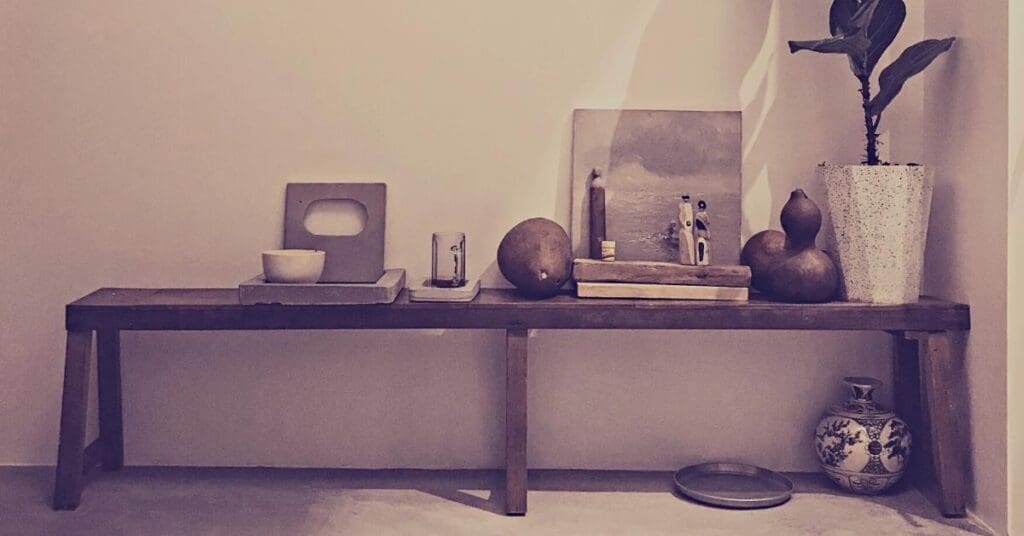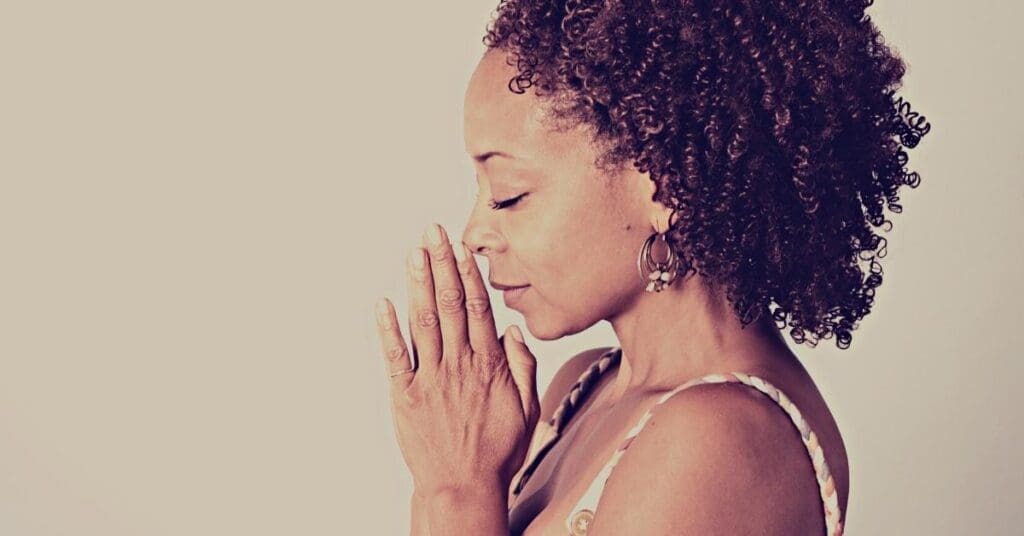Spiritual meditation is an invitation to embark on a spiritual journey that requires you to go deep within yourself to experience spiritual growth. It’s a way to connect with the Divine Energy of the Universe. It is a way for you to remember who you truly are and to find peace in simply being.
Spiritual meditation is a very rewarding experience, though it can also be confusing for many who are starting their spiritual journey. With this introduction to spiritual meditation, I share everything I feel you need to know before starting your own practice. This includes things I wish I knew before beginning my own self-taught practice, and things I have learned from my personal experiences over the last 9 years of practicing spiritual meditation every day.
What is spiritual meditation?

Man practicing spiritual meditation in front of Buddha statue.
The meaning of spiritual meditation differs from mindfulness meditation and other types of meditation practices. You can think of spiritual meditation as an invitation to embark on a spiritual journey that requires you to go deep within yourself to experience spiritual growth or expand your consciousness.
It’s a way to connect with the Divine Energy of the Universe, also known as the One Infinite Creator, or Source Energy. It is a way for you to remember who you truly are and to find peace and solace in simply being. It is a way for you to connect with your authentic self and experience a sense of peace and stillness that is beyond words. This type of meditation can be deeply healing, transformative, and can help you find your true life purpose.
What is the primary goal of spiritual meditation?
The primary goal of spiritual meditation may vary from person to person. Ultimately, it is achieving a direct connection with the Divine Energy of the Universe (the One Infinite Creator), and remembering who you truly are. Most know this as attaining Christ Consciousness, Buddha Consciousness, or Krishna Consciousness. It is also known as going through a kundalini awakening or achieving spiritual enlightenment.
Also, the experience often results in an accelerated learning state, the transformation (death) of your ego, and a reduced attachment to things of the Earth that might keep you from living your true life purpose.
Characteristics of spiritual meditation

Opening your third eye is a characteristic of spiritual meditation.
Spiritual meditation is primarily focused on achieving spiritual enlightenment, unlike mindfulness meditation or music therapy-guided imagery meditation, which may focus on physical or mental aspects of life. But since all things are connected, the physical aspects of life are also affected by spiritual meditation practices.
Below is a deeper look at the characteristics of spiritual meditation that you might experience.
1. Achieving spiritual enlightenment
Achieving spiritual enlightenment is the most common end-goal of spiritual meditation and maybe for some mindfulness meditation practices. It is a testament to how to spiritually meditate properly. The experience is the realization that you are not only your body or your mind but rather, you are pure awareness; you are pure Consciousness. It is remembering that you have always been and always will be. That you are an infinite intelligence having a temporary experience being human on planet Earth.
A spiritual awakening is a profound state of awareness where you connect with your spiritual essence and experience true peace and unconditional love. This is because you are reconnecting to the higher power that is the source of life. This was true for me following my spiritual awakening on August 21st, 2018. I share the special moment in Chapter 5 of my top-rated book, Who and Why You Are: All you need to remember.
Watch an animation of the moment in the video below.
2. Opening your third eye chakra
During spiritual meditation, it is not unusual to feel pressure, pounding, or tingling sensations around your third eye chakra. These strange sensations mean you are opening your third-eye chakra. Opening of the third eye can happen slowly over time, so be patient. In rare cases, this chakra can open instantly.
As this chakra opens, you develop your intuition and trust your own inner guidance. You also create a stronger connection with your higher self, who helps guide you on your life path. You may also experience visions of future events, have more lucid and vivid dreams, and develop the ability to see auras. You may also see entities that are not incarnate in physical bodies. You may even develop the ability to channel entities from other dimensions.
3. Changes in your personal desires
Spiritual meditation often leads to changes in your desires. As you continue the practice, you may begin to see the world and yourself in a new light. You may start to desire different things than you did before, and you may be less afraid of experiencing and going through change. Even very scary things like your fear of death may subside.
As a result of all these changes, you may find that you are now attracted to new friends. You may also begin to change your diet, your beliefs, and philosophy about all of life. One new belief may include you remembering that all things, people, events, and experiences are spiritual entities interacting with themselves. That they are not separate after all. While these changes can be difficult at first, they often result in a more fulfilling life.
4. Improving your emotional and mental health, and wellbeing
Even though spiritual meditation focuses on aspects of the Divine, you also experience physical benefits from doing the practice. This is because your physical self is a direct representation of your formless self. Any changes you make to either one, affect the other.
Spiritual meditation, like mindfulness meditation and other forms of meditation, may benefit you if you have increased stress levels, anxiety, or other mental disorders. Your physical healing may include alleviating ailments and pains. It may mean you start creating a more aligned and positive state of being.
Studies show that people who focus on their spiritual side tend to be less depressed, have better mental health overall, and are more satisfied with their lives. In fact, this type of meditation may even be more beneficial than traditional forms such as mindfulness or relaxation techniques, as it focuses on the Source of who you truly are.
How do you meditate spiritually?

A peaceful place to practice spiritual meditation.
When it comes to answering the question of how to meditate for spiritual growth, know that there is no one right way to do it and there is no wrong way to do it either. The more you practice meditation, the more it becomes a personal practice that can be tailored to fit your own needs, goals, and preferences.
However, there are some basic steps that are common to all types of meditation that can help you get started. Following these steps are how to meditate spiritually for beginners and experienced meditators alike. They’ll support your own spiritual journey.
1. Set an intention
Setting an intention is the most important part of your spiritual meditation practice. Verbalize it or write it down somewhere so you are clear about why you wish to practice spiritual meditation.
When you establish an intention, you are providing yourself with a compass and guide. Knowing where you are going can help keep you on track and focused. Even if your journey is unclear, simply knowing that you are heading in a spiritual direction can be incredibly empowering.
2. Create a peaceful place
Creating a peaceful environment for yourself is also how to spiritually meditate properly. A cozy environment invites the peace and calm needed to support yourself. To do this:
- Find a place in your home that feels comfortable and private.
- Ensure that you won’t get distracted during the duration of your meditation.
- Dim the lights, light some candles, and burn some incense if you wish.
- Use a diffuser with your favorite essential oils to create a peaceful atmosphere.
- Hang pictures or other objects that help you feel connected to your spirituality.
- Add live plants to the space to bring in natural elements.
3. Get into a comfortable position
It is important to find a comfortable position in which to sit or lay when practicing spiritual meditation. This may take some experimentation, as everyone’s body is different. With more practice, you will be able to allow your body to find its own comfortable position. Remember the goal to be comfortable is so that your practice is not interrupted by discomfort.
If you can, sit with a straight back. Your eyes should be closed and your hands resting in your lap with your palms up. Feel free to use a cushion or pillow to raise yourself up so that you are sitting more comfortably. If you are unable to sit up straight, you can also try lying down on your back or side. It is important not to hunch over or curl up, as this can cause pain and discomfort.
One more thing. It is not unusual for you to change your position midway through your practice. If you feel the need to, go ahead. Do not fight it. Changing your position allows you to relax further into your practice.
4. Observe your breathing without interfering with it
Did you know you take about 24,000 breaths a day and are not consciously aware of most of them?
Breathing is what keeps you alive. It is how you announce to the entire universe that you are on Earth. It is how your body gets the energy to power and heal itself. And amazingly, your body breathes very well all on its own.
These are all reasons why observing your body’s ability to breathe is how to meditate for spiritual awakening. In fact, it is the best and most effective way to do it.
Note that the practice requires you to observe only. Do not interfere or consciously breathe. This is easier said than done. You may have the tendency to take over your breathing when you attempt to observe it, instead of simply allowing it to happen naturally. Not to worry, with more practice, it will become easier.
You may also find it hard to focus on your breathing. When your focus has shifted from your breath, return to observing it. Allow your mind to wander without getting attached to its drama. Allow your thoughts to rise and fall without getting attached to them either. Do your very best to return to observing your breathing. Again, this is easier said than done.
Creating a successful meditation practice

Be gentle with yourself when practicing spiritual meditation.
We have established that spiritual meditation is a very rewarding experience. But to reap its benefits, it’s important to set up some ground rules.
Below are a few tips on how you can create a successful spiritual meditation practice:
1. Be gentle with yourself
One of the most important things to remember when beginning a spiritual meditation practice is not to be discouraged if it doesn’t feel perfect from the start. Like everything else, it takes time and patience to master something new. It took me over four years, meditating an average of two hours per day before I experienced my spiritual awakening.
Today, it has been over nine years since I started and I continue to find ways to enhance my practice. That is why it is important to be gentle with yourself, even if you do not feel like you are making the type of progress you expect. Trust me on this, you are always experiencing spiritual growth and change when you meditate, even if you do not realize it.
2. Make it a routine
It goes without saying that if you want to get the most out of spiritual meditation, you’ll need to make it a regular part of your life. Dedicate a specific time each day or week to sit down and focus on your spiritual practice. It will take time to find out what schedule works best for you, and this is normal. Be open to making changes understanding that life does continue to happen.
A great way to support your ability to find a routine is to journal your experiences. Journal both good and bad experiences as this can help you reflect on your progress. Journaling is also a great way to review how much closer you are to achieving your goals, or if practicing spiritual meditation has allowed you to experience things you were not expecting.
3. Connect with others for support
You can also create a successful spiritual meditation practice by connecting with groups or communities of people doing the same thing. This can be very helpful for your motivation and accountability. Completing meditation training online with a guru or meditation coach can also be beneficial, as they will provide guidance and support throughout your spiritual journey.
Above all, it’s important to be patient – don’t expect perfection or instant enlightenment! This might end up being detrimental to your practice. The more you do it, however, the easier it will be for you to see, feel, and experience the benefits.
Spiritual meditation and religious beliefs

A woman practicing spiritual meditation.
If you worry that practicing spiritual meditation goes against your religious beliefs, you are not alone. Many people have such fears, which hinder them from attempting the practice. I was one such person.
When I began meditating, there were many times when I worried I was going against my religious beliefs. I also worried that my soul was possessed by something evil. These thoughts would occur to me when I experienced things I never knew were possible. Things like the tingling sensations of energy moving around in my third eye.
Today, it is my understanding that spiritual meditation is not about religion. I remember that it is not about sinning either unless you make it so. Spiritual meditation is more focused on going deep within yourself to reconnect with the divine and remember who you truly are. Spiritual meditation is an excellent way to help you understand all things and experiences better. It gives you a broader and higher perspective on everything, and this may include your religious beliefs, too.
By practicing spiritual meditation, you are empowering yourself to come to your own conclusions about what you believe and why you believe it.
Conclusion
To wrap this up, remember that spiritual meditation is a powerful practice for connecting with the divine and achieving spiritual enlightenment. If you are wondering how to meditate for spiritual growth, the best way is to learn to observe your body’s ability to breathe on its own without interfering with it. It will be uncomfortable when you begin, but how you learn to meditate like this is by practicing regularly.
As always, it is important to be patient and not get discouraged if you don’t experience results right away. The most important thing is to be consistent with your practice. Find and get support from others practicing spiritual meditation. Finally, remember to love the practice, love the journey, and love yourself along the way. There is no wrong way to meditate spiritually. Your intention coupled with any attempts will have an impact on you.



